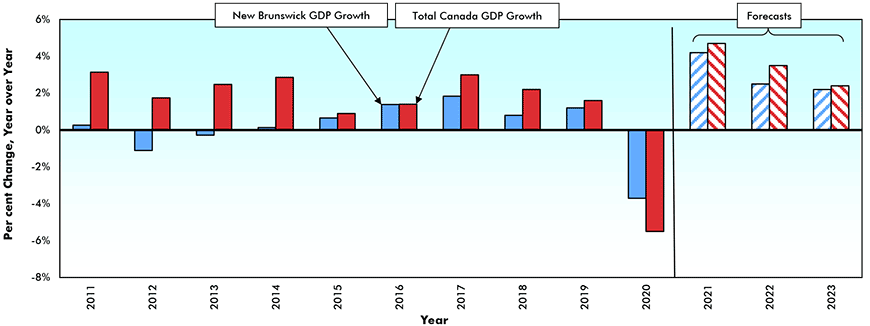With a 14-day case rate of 157 per 100,000 population vs 116 per 100,000 for the entire country, it’s clear the fourth wave of COVID-19 has hit New Brunswick hard. In the face of this headwind, overall hiring in the province has remained flat for the past 11 months while the unemployment rate, currently 9.3%, is the third highest in the land, and well above the national average, now 6.9%. While the overall employment stats are rather bleak, a closer look reveals that full-time hiring is up by +3,000 jobs year to date driven primarily by gains in public administration, education services, and accommodation. Also, according to the , full-time staffing plans in the province are the highest they have been since mid-2019.
Affordable housing a big draw
While the onslaught of successive COVID-19 waves has significantly depressed New Brunswick’s employment growth over the past year, it has had little impact on the inflow of migrants from other provinces as well as from outside Canada. A recent Royal Bank of Canada (RBC) report titled A Regional Renaissance: More Canadians drawn to live on the Atlantic Coast during pandemic indicates the region’s affordable housing has been a major attraction for individuals and families. According to RBC, Saint John, New Brunswick is Canada’s most affordable census metro area. During the first half of this year, net interprovincial migration hit a record +3,300 individuals, which was augmented by a +2,898 increase in international net migration.
Housing starts at 10-year high
Driven by the strong inflow of individuals from outside the province, persisting low-interest rates, and the above-mentioned highly affordable house prices, sales of existing homes year-to-date in N.B. are up by +31% versus the first nine months of 2020 and by +39% over the same period in pre-pandemic 2019.
As a result of this exceptionally strong surge in demand, the months’ supply of homes for sale has, over the past year, dropped from a COVID-19-induced high of 9.4 in April of 2020 to a record low of 2.3 in September 2021. Over the same period, the average house price for the province has accelerated from no change y/y in April 2020 to +22.4% in the latest month. That said, New Brunswick’s average house price at $256,000 is the lowest among provinces and well under the national average of $689,303.
Spurred by the surge in demand, housing starts in New Brunswick year to date are up by +15% versus 2020 and by +34% vis-à-vis 2019. Single, semi, and row starts are up by +58%, more than offsetting a drop of -13% in apartment starts. Given the solid +32.4% year-to-date increase in residential building approvals, housing starts in New Brunswick should total in the range of 4,100 to 4,300 units this year and 3,900 to 4,100 units in 2022 compared to 3,500 units in 2020.
Despite the lacklustre job gains over the past several quarters, consumer spending as reflected by retail sales in New Brunswick are up by +16% YTD over 2020 and by +13% versus the first seven months of pre-pandemic 2019. While the bulk (52%) of the gain in retail sales this year has centred on motor vehicles, sales of house-related goods including furniture and home furnishings (+45%) as well as building materials (+18%) have also been solid, consistent with the healthy pattern of home sales.
N.B.’s exports fuelled by higher oil prices
From an external perspective, due in large part to strong demand for petroleum products in the United States, New Brunswick’s merchandise exports are up by +51% year to date after contracting by -23% in 2020. Other products which have headed south across the border in significant volumes since the beginning of this year are seafood (lobsters and salmon), lumber, and liquid natural gas.
The very strong gain in global energy prices over the past 12 months and a growing consensus that prices will rise further due to a significant slowdown in energy investment, point to a further rise in the value of New Brunswick’s exports well into 2023.
CAPEX to pick up in 2021 and 2022
After posting solid gains of +19% y/y in 2017 and +13% in 2018, capital spending retreated by -10% in 2019 and by the same percentage again in 2020. However, despite the persisting drag of COVID-19 on economic activity since March of 2020, two recent surveys of capital spending in the province are pointing higher. First, Statistics Canada’s Non-residential Capital and Repair Expenditures survey indicates public and private spending will post a gain of +10% this year. Second, the more recent survey of major projects by the indicates that investment in the province will increase by +$2.2 billion, its average level for the past ten years.
Major projects underway or expected to go forward in the near term include the Atlantic Science Enterprise Centre, upgrades to Port Saint John’s container terminal, and upgrades to the Saint John Pulp Mill. Other projects which are approved or near approval include the Mactaquac Generating Station upgrade, the Sisson Mine Project, and the NB Power/Moltex Energy small modular reactor project.
John Clinkard has over 35 years’ experience as an economist in international, national and regional research and analysis with leading financial institutions and media outlets in Canada.
Real* Gross Domestic Product (GDP) Growth —
New Brunswick vs Canada

* “Real” is after adjustment for inflation.
Data Sources: Actuals — Statistics Canada; Forecasts — CanaData.
Chart: ����ӰԺ — CanaData.
Please click on the following link to download the PDF version of this article:










Recent Comments
comments for this post are closed